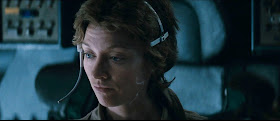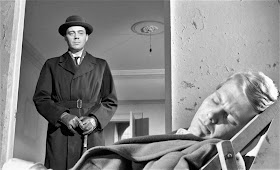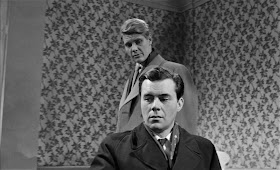The sci-fi
horror thriller Alien turned 40 this
year. And in that time—progressing from sleeper hit to franchise to authentic classic—Ridley
Scott’s 2nd feature film has enjoyed a growth cycle arguably as swift and expansive as that of the titular xenomorph itself. As a rule, science fiction tends to rank somewhere beneath westerns, sports films, espionage thrillers, and war movies in
my roster of least-favorite movie genres, but Alien is a different animal entirely. An ingenious and genuinely scary update of those '50s sci-fi Creature Feature programmers I recall from my youth; Alien is a solid suspense thriller that just happens to take place in outer space. I fell in love with it when I saw it on opening day in 1979, and after all these years, after seeing it countless times, Alien still rates a special place in my heart. Just as long as it's not in my chest.
On the occasion of Alien's 40th Anniversary,
my electronic film diary memories of Alien's opening day, May 25, 1979.
A Cruel Summer
Because movies aren't created in a vacuum, because successes can't be predicted, and because I'm forever fascinated by the almost alchemical selection process by which the public responds to one particular motion picture over another; allow me to take a moment to put the release of Alien in a bit of context by taking a look at what was hitting the theaters in the summer of 1979.
On the topic
of adages (or proverbs), no summer would be complete without echoing homage paid
to: ‘If they liked it once, they’ll love it twice.’ On that score, the Airport and James Bond franchises
persisted with The Concorde… Airport ’79 and Roger Moore’s 4th go-round
as 007 in the 11th Bond film Moonraker.
Meanwhile, major industry money was riding on the sequels Rocky II and More American Graffiti
(the former delivered, the latter, not so much) while somewhere in the distance Irwin Allen was squeezing the life out of the once vital disaster film genre with his unasked for Beyond
the Poseidon Adventure.
For those inclined to play it safe, there were limited-engagement 70mm rereleases of both Grease and The Exorcist. For the gamblers, the summer presented a roster of television personalities making a play for big-screen gold: Charlie’s Angels’ Farrah Fawcett appearing in Sunburn, Three Company’s John Ritter in Americathon, and SNL’s Bill Murray in Meatballs. And if those prospects weren’t scary enough, The Amityville Horror, Prophecy, and Dracula hoped to add a few chills to the summer heat.
What really brought Alien to my attention was when posters for the film began to appear around town. They really grabbed me. I mean, after the PG-rated, retro earnestness of Star Wars and all that benevolent optimism in Close Encounters of the Third Kind, here was an R-rated sci-fi monster movie that held the promise of a creature that wasn't so nice.
 |
| Alien and a then-unknown Sigourney Weaver make the June 18, 1979 cover of Newsweek |
Because movies aren't created in a vacuum, because successes can't be predicted, and because I'm forever fascinated by the almost alchemical selection process by which the public responds to one particular motion picture over another; allow me to take a moment to put the release of Alien in a bit of context by taking a look at what was hitting the theaters in the summer of 1979.
The year began
with new releases from favorites Robert Altman (Quintet, A Perfect Couple),
Woody Allen (Manhattan), & Milos
Forman (Hair). And the fall promised an
original musical from Bob Fosse (All That Jazz), a romantic comedy from Alan J. Pakula (Starting Over), and the film debut of Bette Midler (The Rose). But when I looked ahead to
what the summer months promised in the way of film releases, the Summer of ’79 didn't appear
to be shaping up to be much of a banner season at the movies.
For those who
like their big-name stars served up with as few surprises as possible, there was
Clint Eastwood in Escape from Alcatraz
and Barbra Streisand reteaming with her What’s Up Doc? co-star Ryan O’Neal in The
Main Event (getting a significant publicity boost from La Streisand’s late-to-the-party
stab at disco with the film’s theme song). That summer also saw my beloved Audrey
Hepburn and Ali MacGraw testing the limits of the adage ‘Everybody loves a comeback
story’ by appearing in the high-profile miscalculations Bloodline and Players, respectively.
 |
| Photo: Gary McVey |
For those inclined to play it safe, there were limited-engagement 70mm rereleases of both Grease and The Exorcist. For the gamblers, the summer presented a roster of television personalities making a play for big-screen gold: Charlie’s Angels’ Farrah Fawcett appearing in Sunburn, Three Company’s John Ritter in Americathon, and SNL’s Bill Murray in Meatballs. And if those prospects weren’t scary enough, The Amityville Horror, Prophecy, and Dracula hoped to add a few chills to the summer heat.
What really brought Alien to my attention was when posters for the film began to appear around town. They really grabbed me. I mean, after the PG-rated, retro earnestness of Star Wars and all that benevolent optimism in Close Encounters of the Third Kind, here was an R-rated sci-fi monster movie that held the promise of a creature that wasn't so nice.
 |
| Sigourney Weaver as Warrant Officer Ellen Ripley |
 |
| Tom Skerritt as Captain Arthur Dallas |
 |
| John Hurt as Executive Officer Gilbert Kane |
 |
| Veronica Cartwright as Navigator Joan Lambert |
 |
| Yaphet Kotto as Chief Engineer Denis Parker |
 |
| Harry Dean Stanton as Engineering Technician Samuel Brett |
 |
| Ian Holm as Science Officer Ash the Android |
An Alien Encounter
I saw Alien on the Friday evening of May 25,
1979. The date was the kickoff of a long Memorial Day weekend which also
happened to be the 2nd Anniversary of the blockbuster release of Star Wars. The studio 20th
Century-Fox (no doubt hoping that lightning would strike twice) marked the
occasion by premiering Alien, its new
sci-fi release, in 70mm and Dolby Stereo at the Egyptian Theater on Hollywood
Boulevard. Not an official, invitation-only movie premiere, but an exclusive engagement that had Alien was screened for 48 continuous
hours over that holiday weekend, its debut feted with searchlights, towering
signs, giveaways, lobby displays of props and models, and a massive scale replica of the
film’s “Space Jockey” in the theater’s courtyard (Space Jockey is a name that
came to stick sometime later. Then, still in the flush of Star Wars mania, many referred to it as the “Star Pilot”).
The line I stood in was an incredibly long one that stretched west from the
theater’s massive curved marquee (George Hamilton’s Dracula spoof Love at First Bite—a holdover from April—was
playing in the smaller Egyptian Theaters II and III) past the London Britches blue
jeans store next door (in 1927 it was the Pig 'n' Whistle restaurant), beyond Jambi’s sandwich shop, down to the Pioneer
Chicken take-out on the corner, winding around McCadden Place across from the Scientology
building, all the way down to Selma Avenue.
Certainly, public interest was high for any all science fiction films released while awaiting the December premiere of Star Trek: The Movie, but a contributing factor to Alien's huge turnout had to be that it had the weekend virtually all to itself. Friday the 25th also saw Mann's Chinese Theater regretting booking Peter Sellers' The Prisoner of Zenda (a film I'd wager even his fans have forgotten), and further up the boulevard headed east, minimal competition was offered by the release of David Cronenberg's The Brood.
The buzz standing in line was tremendous because, like Star Wars, Alien was an “event” movie with nary a star in its cast and a film that no one knew anything about. It was a high-concept scary movie whose marketing seized the imagination by playing up the ambiguity. With a campaign and poster designed by the same team responsible for the groundbreaking marketing campaign for Rosemary’s Baby, everything from Alien’s trailer to TV ads were all about what you didn’t know and what you couldn’t see. Similarities to the iconic 1968 Rosemary’s Baby poster could be seen in Alien’s eerie green/black color scheme, its arrestingly simple typeface, the bold graphic of a scabrous egg emitting a green vapor from a glowing crack in its surface, and that irresistible, unforgettable (now classic) tagline: In space no one can hear you scream.
Certainly, public interest was high for any all science fiction films released while awaiting the December premiere of Star Trek: The Movie, but a contributing factor to Alien's huge turnout had to be that it had the weekend virtually all to itself. Friday the 25th also saw Mann's Chinese Theater regretting booking Peter Sellers' The Prisoner of Zenda (a film I'd wager even his fans have forgotten), and further up the boulevard headed east, minimal competition was offered by the release of David Cronenberg's The Brood.
The buzz standing in line was tremendous because, like Star Wars, Alien was an “event” movie with nary a star in its cast and a film that no one knew anything about. It was a high-concept scary movie whose marketing seized the imagination by playing up the ambiguity. With a campaign and poster designed by the same team responsible for the groundbreaking marketing campaign for Rosemary’s Baby, everything from Alien’s trailer to TV ads were all about what you didn’t know and what you couldn’t see. Similarities to the iconic 1968 Rosemary’s Baby poster could be seen in Alien’s eerie green/black color scheme, its arrestingly simple typeface, the bold graphic of a scabrous egg emitting a green vapor from a glowing crack in its surface, and that irresistible, unforgettable (now classic) tagline: In space no one can hear you scream.
 |
| Philip Gips, Barbara Gips, Stephen Frankfurt, Paula Silver, Gina Stone, Belott-Wolfson photography |
A significant
part of my excitement that night was anticipation born of simply not knowing
what I was in for. I didn't know anything about Ridley Scott or designer H.R. Giger,
and I’d never heard of a Sigourney Weaver, much less knew how to pronounce it. Everyone
else in the cast was familiar in a vague kind of way from TV episodics or small
roles in films. Tom Skerritt I remembered from playing Shirley MacLaine’s
husband in The Turning Point (1977),
Yaphet Kotto as the bad guy in Live and
Let Die (1973), John Hurt from when PBS aired The Naked Civil Servant back in 1976, and Harry Dean Stanton from appearing
in practically every TV show on the air in the ‘60s. Curiously enough, Alien’s biggest star and primary draw
for me was Veronica Cartwright, the versatile and underappreciated actress I’d
fallen in love with after seeing her in Inserts
(1975), Bernice Bobs Her Hair (1976),
and nearly walking away with the remake of Invasion of the Body Snatchers (1978).
While I’ve
since matured (calcified?) into the kind of person who runs in the opposite direction at the mere sight of a line forming, back in May of 1979 when I was a 21-year-old with a far more gregarious nature, the idea of waiting in a line for two hours to see a film merely added
to the overall excitement of the moviegoing experience. The evening the general atmosphere
on the line was genial and full of anticipation, and with no cell phones to bury our heads in while waiting, many of us joined in conversation with the folks standing near us in line, each of us comparing notes about how much or how little we knew. And what with the aforementioned Jambi’s sandwich shop and Pioneer Chicken take-out doing land-office business with patrons sitting along the boulevard eating and drinking, waiting to see Alien also felt like an automobile-free tailgate party.
A funny thing about standing in line for a new film, especially on a street as heavily traveled by tourists as Hollywood Blvd, you can find yourself seized by this foolish, decidedly silly notion that you have suddenly become part of the city's attractions to gawking out-of-towners. Just standing there amongst the Walk of Fame stars on the sidewalk and the beaming Klieg lights at the curb, you are no longer yourself, you are now "a huge line outside the Hollywood premiere of Alien" in somebody's vacation anecdote.
A funny thing about standing in line for a new film, especially on a street as heavily traveled by tourists as Hollywood Blvd, you can find yourself seized by this foolish, decidedly silly notion that you have suddenly become part of the city's attractions to gawking out-of-towners. Just standing there amongst the Walk of Fame stars on the sidewalk and the beaming Klieg lights at the curb, you are no longer yourself, you are now "a huge line outside the Hollywood premiere of Alien" in somebody's vacation anecdote.
 |
| Photo: William Malone
Prop of the Alien Egg Chamber
|
As the line progressed further into the theater’s then-roofed courtyard, things began to take on the feel of an amusement park. Following a barricaded path to the theater entrance, patrons were led through the dark, padded hallway of a spaceship when then opened out into a rather dazzling geometric room of tiny yellow lights and computer screens. This, of course, was the mainframe computer room of The Nostromo, but at the time I only had Disneyland’s Space Mountain ride as a point of reference, and that’s what it all reminded me of.
 |
| Photo: Lisa Morton |
 |
| Photo: Alien Explorations |
 |
| Photo: William Malone |
At last, we
were at the entrance to the theater. Regrettably, my awareness of the throngs
of people waiting to get in, combined with my obsession with grabbing the ideal
seat smack dab in the middle of the auditorium, prevented me from even noticing
that there were more props and models from Alien
on display in the lobby. I simply dashed to my seat, ignoring the snack bar and the very likely prospect of a souvenir program for sale (you can get a look at all the lobby props I personally missed at this blogger's account of the Alien premiere Here).
Upon entering the auditorium, early arrivals were given a free promotional pinback button. An item that triggered an ungrateful, inner “WTF?” response from me.
Upon entering the auditorium, early arrivals were given a free promotional pinback button. An item that triggered an ungrateful, inner “WTF?” response from me.
The reason is that
the free souvenir button didn’t feature the film’s tagline, a picture of one of those
alien eggs, or even the film’s title. Any of which I’d have been happy to have.
No, it was a black button approximately 2 ½ inches in diameter that simply had
the words “You Are My Lucky Star” printed on a starry background. Hindsight
plainly reveals this to be a very clever giveaway that patrons wouldn't appreciate until after they'd seen the film (Ripley sings the song to herself in the climactic scene as a means of calming her nerves) but
at the time all I could think was what the hell did a tune from Broadway
Melody of 1936 have to do with Alien?
 |
| I still have my souvenir Alien button. |
These days,
especially here in L.A., it’s not uncommon for movie theaters to display the props
and costumes of films on exhibit in their lobbies. But back in 1979 such pomp
and circumstance were largely the stuff of star-studded premieres and rarely
available to the public. That novelty factor is perhaps why the Egyptian put faith in the honor system and left the safety of its display items in the hands of just a few strategically placed “Please Do Not Touch the Display” signs. When I returned to the theater the following weekend to see Alien a second time, the props had all been
removed due to someone having set the Space Jockey sculpture on fire. Imagine, an extraterrestrial fossil surviving all that time on a planetoid, only to be demolished in a matter of days when confronted with the boundless stupidity of what passes for "intelligent life" on this rock called earth.
 |
| Strange Shapes |
What did I ultimately think of the film and what were my overall impressions?
That's for my next post.
Happy Birthday, Alien!
Read my review ALIEN the film, not the opening day experience, HERE






























